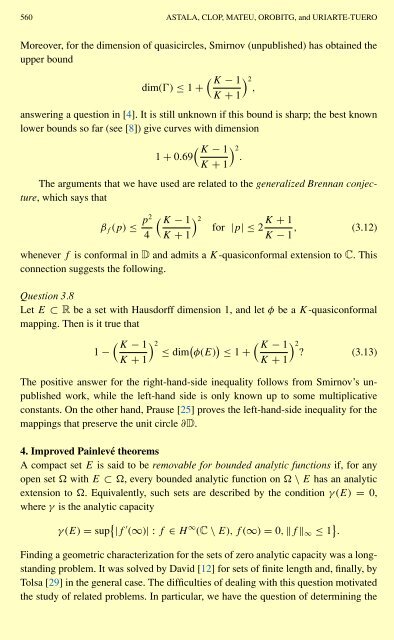A NULLSTELLENSATZ FOR AMOEBAS
A NULLSTELLENSATZ FOR AMOEBAS
A NULLSTELLENSATZ FOR AMOEBAS
You also want an ePaper? Increase the reach of your titles
YUMPU automatically turns print PDFs into web optimized ePapers that Google loves.
560 ASTALA, CLOP, MATEU, OROBITG, and URIARTE-TUERO<br />
Moreover, for the dimension of quasicircles, Smirnov (unpublished) has obtained the<br />
upper bound<br />
dim(Ɣ) ≤ 1 +<br />
( K − 1<br />
) 2,<br />
K + 1<br />
answering a question in [4]. It is still unknown if this bound is sharp; the best known<br />
lower bounds so far (see [8]) give curves with dimension<br />
( K − 1<br />
) 2.<br />
1 + 0.69<br />
K + 1<br />
The arguments that we have used are related to the generalized Brennan conjecture,<br />
which says that<br />
β f (p) ≤ p2<br />
4<br />
( K − 1<br />
) 2<br />
for |p| ≤2 K + 1<br />
K + 1<br />
K − 1 , (3.12)<br />
whenever f is conformal in D and admits a K-quasiconformal extension to C. This<br />
connection suggests the following.<br />
Question 3.8<br />
Let E ⊂ R be a set with Hausdorff dimension 1, andletφ be a K-quasiconformal<br />
mapping. Then is it true that<br />
1 −<br />
( K − 1<br />
) 2 ( ) ( K − 1<br />
) 2?<br />
≤ dim φ(E) ≤ 1 + (3.13)<br />
K + 1<br />
K + 1<br />
The positive answer for the right-hand-side inequality follows from Smirnov’s unpublished<br />
work, while the left-hand side is only known up to some multiplicative<br />
constants. On the other hand, Prause [25] proves the left-hand-side inequality for the<br />
mappings that preserve the unit circle ∂D.<br />
4. Improved Painlevé theorems<br />
A compact set E is said to be removable for bounded analytic functions if, for any<br />
open set with E ⊂ , every bounded analytic function on \ E has an analytic<br />
extension to . Equivalently, such sets are described by the condition γ (E) = 0,<br />
where γ is the analytic capacity<br />
γ (E) = sup { |f ′ (∞)| : f ∈ H ∞ (C \ E),f(∞) = 0, ‖f ‖ ∞ ≤ 1 } .<br />
Finding a geometric characterization for the sets of zero analytic capacity was a longstanding<br />
problem. It was solved by David [12] for sets of finite length and, finally, by<br />
Tolsa [29] in the general case. The difficulties of dealing with this question motivated<br />
the study of related problems. In particular, we have the question of determining the
















